- Joined
- Feb 2, 2011
- Messages
- 2,384
JJDESIGNS NEWS UPDATE 20th OCTOBER 2025
THE EIGHTEENTH CENTURY COLLECTION
SETTLERS AND REFUGEES
European settlers came to North America from a variety of social and religious groups, including adventurers, farmers, indentured servants, tradesmen, and a very few from the aristocracy.
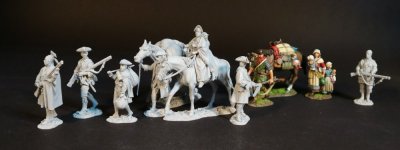
From the 1700’s settlements were mainly found along the coast, with only in the valley of the Hudson River had they penetrated inland more than a 100 miles.
Seventy years later settlements had spread inland 200 miles or more, to the crest of the Appalachians.
Before 1754 the westward expansion was slowed by the hostility of local tribes angered by the invasion of European settlers, and who were also incited by French and Spanish agents.
The French and Indian War began over the specific issue of whether the upper Ohio River valley was a part of the British Empire and therefore open for trade and settlement by Virginians and Pennsylvanians, or if it was part of the French Empire.
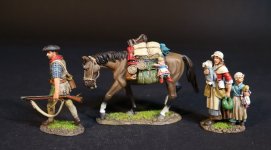
This war, fought by the British against the French for control of the territory for trade and settlement, was very expensive, which led to the post war British government implementing new taxes in the Thirteen Colonies.
The American Revolution was primarily caused by an erosion in the relationship between the British government and the Thirteen Colonies of America.
There were a number of reasons why this relationship broke down to the extent that it did, leading to a full scale war between the two sides.
Tory Refugees on their way to Canada by Howard Pyle
Howard Pyle (March 5th 1853 – November 9th 1911) was an American illustrator, painter and author. His work “Tory Refugees On their Way To Canada” appeared in Harper’s Monthly in December 1901.
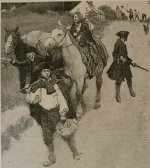
In the aftermath of General Burgoyne’s defeat at Saratoga, many loyalists in the New York and Hampshire Grant regions chose to flee to the safety of Canada rather than face the prospects of poor treatment, forfeiture of property and imprisonment at the hands of the local revolutionaries.
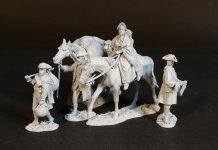
Loyalist refugees traveled north to Canada, usually along two routes. New York loyalists typically followed an overland route through Native American territory to Lake Ontario. As most of the route was along forest trails, Indian guides were essential.
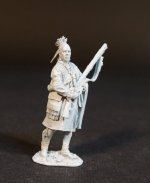
Unfortunately for many of the refugees, this included passage through territory held by the Oneidas, who were allies of the Americans. Continental and militia detachments that actively patrolled the region had also to be avoided.
Some loyalists might be lucky enough to make the trip in thirteen days, but most took much longer. An expedition of women and children that had to move slowly, would probably miss its boat connections, and with bad weather could take from two to three months to reach the Quebec province.
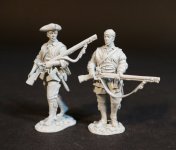
The King’s Royal Regiment of New York, or Johnson’s Royal Regiment of New York, was formed by exiled Loyalist leader, Sir John Johnson, from American refugees fleeing persecution.
The regiment served with distinction throughout the war, launching raids and relief missions into the Mohawk Valley of New York.
Each year the regiment sent parties on raids into the Mohawk and neighboring valleys for the purposes of rescuing and escorting beleaguered Loyalists, and interfering with the ability of the Continental Army forces to use the region’s crops as a source of food for Washington’s army.
The British government controlling Canada was ill prepared for the arrival of thousands of men, women and children, who Governor Frederick Haldimand fittingly described as “loyalists in great distress”.
Incoming loyalists were questioned to determine what trade or profession they possessed and then were dispatched to specific locations to seek employment.
Others were assigned to refugee camps, where they were expected to work in exchange for aid.
The efforts of the British government to provide asylum for the loyalists were often in vain, and as the years progressed, existing difficulties were compounded with an ever greater influx of refugees.
PLEASE NOTE THE FIRST OF THE REFUGEE/SETTLER SETS WILL BE AVAILABLE IN DECEMBER.
Best wishes,
john jenkins
THE EIGHTEENTH CENTURY COLLECTION
SETTLERS AND REFUGEES
European settlers came to North America from a variety of social and religious groups, including adventurers, farmers, indentured servants, tradesmen, and a very few from the aristocracy.

From the 1700’s settlements were mainly found along the coast, with only in the valley of the Hudson River had they penetrated inland more than a 100 miles.
Seventy years later settlements had spread inland 200 miles or more, to the crest of the Appalachians.
Before 1754 the westward expansion was slowed by the hostility of local tribes angered by the invasion of European settlers, and who were also incited by French and Spanish agents.
The French and Indian War began over the specific issue of whether the upper Ohio River valley was a part of the British Empire and therefore open for trade and settlement by Virginians and Pennsylvanians, or if it was part of the French Empire.

This war, fought by the British against the French for control of the territory for trade and settlement, was very expensive, which led to the post war British government implementing new taxes in the Thirteen Colonies.
The American Revolution was primarily caused by an erosion in the relationship between the British government and the Thirteen Colonies of America.
There were a number of reasons why this relationship broke down to the extent that it did, leading to a full scale war between the two sides.
Tory Refugees on their way to Canada by Howard Pyle
Howard Pyle (March 5th 1853 – November 9th 1911) was an American illustrator, painter and author. His work “Tory Refugees On their Way To Canada” appeared in Harper’s Monthly in December 1901.

In the aftermath of General Burgoyne’s defeat at Saratoga, many loyalists in the New York and Hampshire Grant regions chose to flee to the safety of Canada rather than face the prospects of poor treatment, forfeiture of property and imprisonment at the hands of the local revolutionaries.

Loyalist refugees traveled north to Canada, usually along two routes. New York loyalists typically followed an overland route through Native American territory to Lake Ontario. As most of the route was along forest trails, Indian guides were essential.

Unfortunately for many of the refugees, this included passage through territory held by the Oneidas, who were allies of the Americans. Continental and militia detachments that actively patrolled the region had also to be avoided.
Some loyalists might be lucky enough to make the trip in thirteen days, but most took much longer. An expedition of women and children that had to move slowly, would probably miss its boat connections, and with bad weather could take from two to three months to reach the Quebec province.

The King’s Royal Regiment of New York, or Johnson’s Royal Regiment of New York, was formed by exiled Loyalist leader, Sir John Johnson, from American refugees fleeing persecution.
The regiment served with distinction throughout the war, launching raids and relief missions into the Mohawk Valley of New York.
Each year the regiment sent parties on raids into the Mohawk and neighboring valleys for the purposes of rescuing and escorting beleaguered Loyalists, and interfering with the ability of the Continental Army forces to use the region’s crops as a source of food for Washington’s army.
The British government controlling Canada was ill prepared for the arrival of thousands of men, women and children, who Governor Frederick Haldimand fittingly described as “loyalists in great distress”.
Incoming loyalists were questioned to determine what trade or profession they possessed and then were dispatched to specific locations to seek employment.
Others were assigned to refugee camps, where they were expected to work in exchange for aid.
The efforts of the British government to provide asylum for the loyalists were often in vain, and as the years progressed, existing difficulties were compounded with an ever greater influx of refugees.
PLEASE NOTE THE FIRST OF THE REFUGEE/SETTLER SETS WILL BE AVAILABLE IN DECEMBER.
Best wishes,
john jenkins

